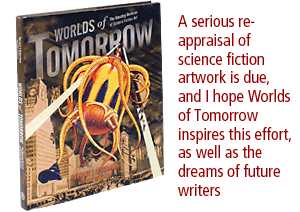| |
 |
 |
 |
Worlds of Tomorrow
The Amazing Universe of Science Fiction Art
 By Forrest J. Ackerman with Brad Linaweaver By Forrest J. Ackerman with Brad Linaweaver
Portland: Collectors Press, 2004
176 pages. $39.95
ISBN: 188805493X
The Golden Age of Science Fiction spanned the middle of the twentieth century, roughly 1920–1970, give or take a decade and a few heated arguments among fans. The groundwork was laid in the science romances of H. G. Wells and Jules Verne, and the genre came of age in magazines and anthologies with hyperbolic titles like Amazing Stories, Super Science and Fantastic Stories, Thrilling Wonder Stories, and Uncanny Tales. To lure the reader of “scientifiction,” usually young and male, publishers adorned their rags with eye-catching artwork, combining outlandish images with garish colors and suggestions of overheated narratives. I remember rooting through old copies of these magazines as a kid, finding them in old bookstores and in the back of garages and basements.
Worlds of Tomorrow is a
lavish cornucopia of these imaginative and colorful creations. Ackerman and
Linaweaver have collected and assembled covers from pulp magazines and paperback
books, starting in the late 1920s and finishing in the early 1960s, just
as the world was catching up with the old scientifiction dreams of the space
race and computer technology. Many of the titles come from the prolific Hugo
Gernsback, the publisher who promulgated the most famous golden age periodicals
and whose name graces one of sci-fi literature’s most prestigious awards
(the Hugo). Other covers are more obscure and exotic: B- thru Z-grade titles
from vanished American and European
publishers. Many authors will be familiar to collectors (Ray Bradbury,
Isaac Asimov) while others (Volsted Gridban?) are as unknown as the strange
worlds they portray.
The book is divided into chapters organized around four
major visual themes depicted in sci-fi cover art: the world of
tomorrow, spaceships, robots, and aliens. Ackerman and Linaweaver
celebrate the overlooked accomplishments of genre artists such as
Frank R. Paul, Robert Schulz, Leo Morey, and Elliott Dold, who imagined and
rendered the first popular images of rocket ships, space planes, robots,
and alien life forms. Linaweaver points out the difference between the
sleek single-stage rockets (usually atomic
powered) that graced these covers and the multiple-stage rockets eventually
used by NASA. “There is no reason that something like the 1950s super-atomic
rocket ship couldn’t exist,” Linaweaver speculates. “All
that is required is repealing all environmental laws, scrapping all test
ban treaties…and busting the budget!”
The covers reflected narratives and values inherited
from pulp adventures and serials by Edgar Rice Burroughs and H. Rider
Haggard and their manly colonialism. Aliens were often BEM (bug-eyed
monsters), little more than untamed savages who needed to be vanquished by
the fair-haired hero and his buxom heroine. But many artists pushed the
envelope, realizing images of interstellar harmony, even romance between
humans and aliens. Their cover illustrations highlighted the complexities
and hypocrisies in technological advancement—is mankind ready for
these new wonders?—sometimes with subtlety
unexpected for the genre.
Worlds of Tomorrow is a
beautifully designed and assembled book.
The reproductions vividly capture the original cover colors. Kudos to
Collectors Press for the quality of printing and good graphic design that
enhances reading: typically two or three covers spaciously arranged on each
page. After a few readings, contemporary book covers seem tame by comparison.
Perhaps they’re
reigned in by marketing algorithms that pigeonhole these early sci-fi
images as primitive and infantile. This is a gross misrepresentation. The
covers often incorporate elements of the artistic movements of their day,
such as Expressionism and Surrealism, and many prefigure Pop Art in
the late twentieth century.
Author Forrest Ackerman is affectionately known among
sci-fi collectors and aficionados as “Mr. Science Fiction.”
That moniker isn’t as hyperbolic as the magazine titles in his
collection. A lifelong resident of Los Angeles, Ackerman has been
collecting science fiction movie and literary memorabilia for over seventy
years, at one point amassing 300,000 artifacts that he displayed in his house.
He allegedly coined the term “sci-fi” around 1958.
This book is as much a celebration of Ackerman’s
influence on writers and generations of fans as of the covers themselves.
Therein is the book’s Achilles’s heel. The accompanying text
is more celebratory than explanatory. Ackerman and Linaweaver are citizens
of the golden age, and their enthusiasm is as unbridled and upbeat as the
visions they’ve
assembled. They are good boosters, and Ackerman’s name should
be more widely known outside genre circles than it is, but the writing
frequently turns tongue-in-cheek and veers into exhortations that could have
come from a 1950s horror movie. I expected more insight and
revelation. In Worlds of Tomorrow, the text, written by enthusiasts
for enthusiasts, is a
bystander–the eye feasts on the fantastic candy around it.
The future predicted in the golden age didn’t
materialize the way its authors and artists anticipated. We have weapons
of mass destruction, cell phones, space planes (the space shuttle),
and computers, but we didn’t get flying
cars or jet packs (darn). Undelivered prophecies
aside, golden age sci-fi had an incalculable
influence on movies, art and architecture,
science, and technology. Many of its fans became the scientists,
technologists, and dreamers who continue to pioneer new wonders in the
twenty-first century. A serious re-appraisal of science fiction artwork
is due, and I hope Worlds of Tomorrow inspires
this effort, as well as the dreams of future writers and achievers. Maybe
we’ll get those flying cars someday.
Aspects on the History of Books and
Book-Collecting in America
By Robert A. Shaddy
 Lewiston, NY: Edwin Mellen Press, 2003
Lewiston, NY: Edwin Mellen Press, 2003
162 pages. $99.95
ISBN: 0773466428
Old Books Are Best”
reads the title of Beverly Chew’s poem, one of the many
examples of booklore Robert Shaddy collects in Essays
on Books and Bibliophiles. Chew, a founding
member of the Grolier Club, continues with verse touching on his true
love, “What though the prints be not so bright, / The paper dark,
the binding slight? / Our author, be he dull or sage, / Returning from
that distant age / So lives again, we say of right: / Old Books are best.”
Shaddy, Librarian and Chair of Special and Area Studies Collections at
the University of Florida, illustrates
his study of late-nineteenth- and early-twentieth-century bookmen with
similarly amusing anecdotes; he augments his research on what he calls the
Golden Age of Collecting with a profile of Randolph Greenfield Adams and
the rise of the bibliophile-librarian, a regional study of three prominent
Missouri collectors, and extensive bibliographic resources. As
the title suggests, the book is very much an academic study, and true to
form, its only weakness is the lack of a strong narrative carrying the reader
forward. While this perhaps betrays the likely origins in academic conference
papers, the richness of the material he has gathered makes Essays worthwhile
and informative.
The book’s most fascinating scholarship concerns
the distinction between the “delicious fever” of the
bibliophile and the “delirium” of the bibliomaniac. The
“malady” of the bibliomaniac, Shaddy writes, “can be
likened to the book world’s equivalent of the social drinker turned
alcoholic.” The problem for these men (and they are all men here) is
their somewhat unnatural attachment to the physical object. Reading
Alexander Ireland’s anthology, The
Book-Lover’s Enchiridion, Shaddy
repeatedly uncovers “the themes of books as friends, as being alive,
undying, immortal entities,” as in English essayist and poet Leigh
Hunt’s description of “how natural it was for his friend Charles
Lamb, who felt as he did about books, ‘to give a kiss to an old
folio.’”
Some readers may recognize themselves with
embarrassment in these pages, since bibliomania’s symptoms apparently
include “an excessive regard for books, an obsession or inordinate
passion for a great many books, and an obsession for books as an end
in and of itself.” Does any of this sound familiar? “One chose
books while the other amassed them,” writes influential French author
and Bibliothèque de l’Arsenal librarian Charles Nodier on the
distinction between the bibliophile and the bibliomaniac. Unfortunately,
sagging shelves and frustrated spouses will usually fail to
distinguish between the two. Shaddy’s book may inspire some
self-analysis among acquisitive types, but in presenting his insightful
research, peppered with original and amusing bits of prominent
collectors’ reflections, Essays ultimately justifies continued
book love and is a good match for any deliciously fevered or delirious collector.
|
|
|